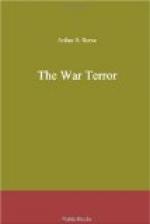On the way he dropped into the hardware store and purchased a light spade and one of the small pocket electric flashlights, about which he wrapped a piece of cardboard in such a way as to make a most effective dark lantern.
We trudged along in silence, occasionally changing from carrying the heavy package to the light spade.
Both the Pearcy and Minturn houses were in nearly total darkness when we arrived. They set well back from the road and were plentifully shielded by shrubbery. Then, too, at night it was not a much frequented neighborhood. We could easily hear the footsteps of anyone approaching on the walk, and an occasional automobile gliding past did not worry us in the least.
“I have calculated carefully from an examination of the water company’s map,” said Craig, “just where the water pipe of the two houses branches off from the main in the road.”
After a measurement or two from some landmark, we set to work a few feet inside, under cover of the bushes and the shadows, like two grave diggers.
Kennedy had been wielding the spade vigorously for a few minutes when it touched something metallic. There, just beneath the frost line, we came upon the service pipe.
He widened the hole, and carefully scraped off the damp earth that adhered to the pipe. Next he found a valve where he shut off the water and cut out a small piece of the pipe.
“I hope they don’t suspect anything like this in the houses with their water cut off,” he remarked as he carefully split the piece open lengthwise and examined it under the light.
On the interior of the pipe could be seen patchy lumps of white which projected about an eighth of an inch above the internal surface. As the pipe dried in the warm night air, they could easily be brushed off as a white powder.
“What is it—strychnine?” I asked.
“No,” he replied, regarding it thoughtfully with some satisfaction. “That is lead carbonate. There can be no doubt that the turbidity of the water was due to this powder in suspension. A little dissolves in the water, while the scales and incrustations in fine particles are carried along in the current. As a matter of fact the amount necessary to make the water poisonous need not be large.”
He applied a little instrument to the cut ends of the pipe. As I bent over, I could see the needle on its dial deflected just a bit.
“My voltmeter,” he said, reading it, “shows that there is a current of about 1.8 volts passing through this pipe all the time.”
“Electrolysis of water pipes!” I exclaimed, thinking of statements I had heard by engineers. “That’s what they mean by stray or vagabond currents, isn’t it?”
He had seized the lantern and was eagerly following up and down the line of the water pipe. At last he stopped, with a low exclamation, at a point where an electric light wire supplying the Minturn cottage crossed overhead. Fastened inconspicuously to the trunk of a tree which served as a support for the wire was another wire which led down from it and was buried in the ground.




